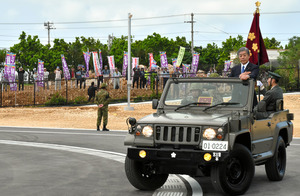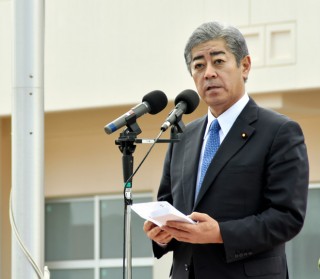Loading
Search
▼ Japan Deploying Longer-Range Missiles To Counter China
- Category:Event
Japan is introducing longer-range missiles to counter China’s maritime expansion, but acquiring the potential to attack enemy bases could contravene the nation’s exclusively defensive posture.
Defense Minister Takeshi Iwaya described Miyakojima island in Okinawa Prefecture as “Japan’s forefront line of defense” during his visit to the island in early April.
Iwaya expressed a strong wariness over China’s growing military capabilities in his speech at the Ground Self-Defense Force’s new camp, which opened in late March.
“(China) has been rapidly strengthening its military power in a wide range of areas, and its activities in the waters and skies around our country have been expanded and boosted,” he said.
At the Miyakojima camp, new surface-to-air and surface-to-ship missile units will be deployed in March next year at the earliest.
While the range of both missiles is more than 100 kilometers, the Type 12 surface-to-ship missile is planned to be improved to cover 300 km.
Within 200 km from Miyakojima are the Senkaku Islands, which are controlled by Tokyo but also claimed by Beijing, and the Yaeyama island chain.
In fiscal 2018, Chinese fighters and bombers flew over the Miyako Strait between Miyakojima and the main Okinawa island on 10 occasions. Chinese naval vessels passed through the strait 12 times.
China has been bolstering its effective control over waters inside what it calls the First Island Chain linking Okinawa and other islands in Japan’s southwestern waters with Taiwan and the Philippines to prevent enemy forces from approaching the area.
Defense Minister Takeshi Iwaya described Miyakojima island in Okinawa Prefecture as “Japan’s forefront line of defense” during his visit to the island in early April.
Iwaya expressed a strong wariness over China’s growing military capabilities in his speech at the Ground Self-Defense Force’s new camp, which opened in late March.
“(China) has been rapidly strengthening its military power in a wide range of areas, and its activities in the waters and skies around our country have been expanded and boosted,” he said.
At the Miyakojima camp, new surface-to-air and surface-to-ship missile units will be deployed in March next year at the earliest.
While the range of both missiles is more than 100 kilometers, the Type 12 surface-to-ship missile is planned to be improved to cover 300 km.
Within 200 km from Miyakojima are the Senkaku Islands, which are controlled by Tokyo but also claimed by Beijing, and the Yaeyama island chain.
In fiscal 2018, Chinese fighters and bombers flew over the Miyako Strait between Miyakojima and the main Okinawa island on 10 occasions. Chinese naval vessels passed through the strait 12 times.
China has been bolstering its effective control over waters inside what it calls the First Island Chain linking Okinawa and other islands in Japan’s southwestern waters with Taiwan and the Philippines to prevent enemy forces from approaching the area.

In line with this strategy known as Anti Access/Area Denial (A2/AD), Beijing is deploying anti-ship ballistic missiles and long-range cruise missiles.
Tokyo plans to counter China’s moves by extending the range of its missiles.
“With the range of (China’s) weapons becoming increasingly longer, longer-range weaponry is essential to deal with the situation while ensuring the safety of Self-Defense Forces personnel,” Iwaya said at a news conference in March.
A senior Defense Ministry official called the planned deployment of long-range missiles “the Japanese version of the A2/AD.”
The ministry is developing a high-speed gliding missile that can fly up to 1,000 km to protect the nation’s outlying islands.
The warhead will be separated after its launch from the ground, allowing the missile to glide in complex flight paths to attack enemy bases without being detected by radar. It can travel at Mach 5, five times faster than the speed of sound.
“The new missile will prove effective in the event of an emergency in the Senkakus if deployed on Ishigakijima island (in Okinawa Prefecture) and elsewhere,” said a senior ministry official.
The range of the ASM-3 air-to-ship missile, which was developed in fiscal 2017, will also be doubled from the current 200 km to 400 km.
The introduction of long-range missiles could lead to a strike capability against enemy bases, something that successive Japanese administrations refrained from acquiring to maintain consistency with its defense-only policy under the nation’s pacifist Constitution.
Prime Minister Shinzo Abe emphasized in February last year that Japan has not changed its traditional defense policy and will concentrate on protecting itself in an emergency.
“Under the division of roles between Tokyo and Washington, Japan depends on the attack capabilities of the United States for any strike against enemy bases,” Abe said during a Lower House Budget Committee session.
Still, long-range cruise missiles called JASSM-ER and LRASM, which Japan plans to deploy in the future, have a range of 900 km each, meaning they can reach North Korea, Russia and inland China when launched from Japanese territory.
Although the Abe administration argues that those missiles are not aimed at attacking enemy bases, a Defense Ministry official described the move as problematic.
“It is dangerous to introduce longer-range missiles without holding a debate on whether Japan should acquire strike capability against enemy bases,” the official said.
Tokyo plans to counter China’s moves by extending the range of its missiles.
“With the range of (China’s) weapons becoming increasingly longer, longer-range weaponry is essential to deal with the situation while ensuring the safety of Self-Defense Forces personnel,” Iwaya said at a news conference in March.
A senior Defense Ministry official called the planned deployment of long-range missiles “the Japanese version of the A2/AD.”
The ministry is developing a high-speed gliding missile that can fly up to 1,000 km to protect the nation’s outlying islands.
The warhead will be separated after its launch from the ground, allowing the missile to glide in complex flight paths to attack enemy bases without being detected by radar. It can travel at Mach 5, five times faster than the speed of sound.
“The new missile will prove effective in the event of an emergency in the Senkakus if deployed on Ishigakijima island (in Okinawa Prefecture) and elsewhere,” said a senior ministry official.
The range of the ASM-3 air-to-ship missile, which was developed in fiscal 2017, will also be doubled from the current 200 km to 400 km.
The introduction of long-range missiles could lead to a strike capability against enemy bases, something that successive Japanese administrations refrained from acquiring to maintain consistency with its defense-only policy under the nation’s pacifist Constitution.
Prime Minister Shinzo Abe emphasized in February last year that Japan has not changed its traditional defense policy and will concentrate on protecting itself in an emergency.
“Under the division of roles between Tokyo and Washington, Japan depends on the attack capabilities of the United States for any strike against enemy bases,” Abe said during a Lower House Budget Committee session.
Still, long-range cruise missiles called JASSM-ER and LRASM, which Japan plans to deploy in the future, have a range of 900 km each, meaning they can reach North Korea, Russia and inland China when launched from Japanese territory.
Although the Abe administration argues that those missiles are not aimed at attacking enemy bases, a Defense Ministry official described the move as problematic.
“It is dangerous to introduce longer-range missiles without holding a debate on whether Japan should acquire strike capability against enemy bases,” the official said.
- April 30, 2019
- Comment (0)
- Trackback(0)


